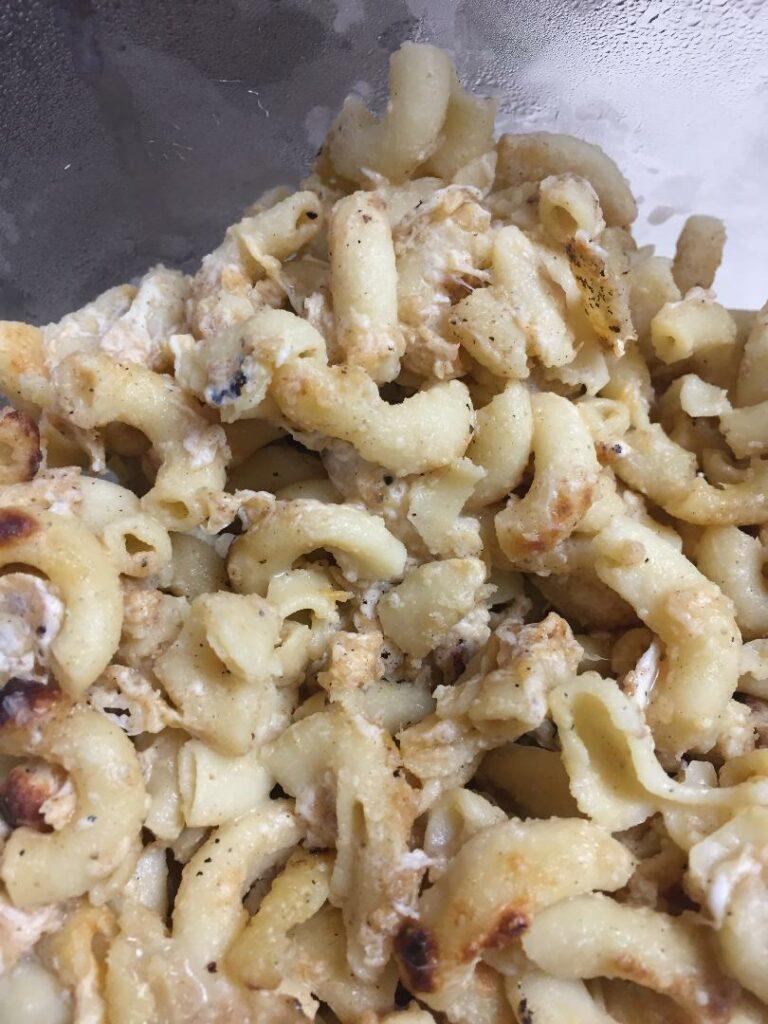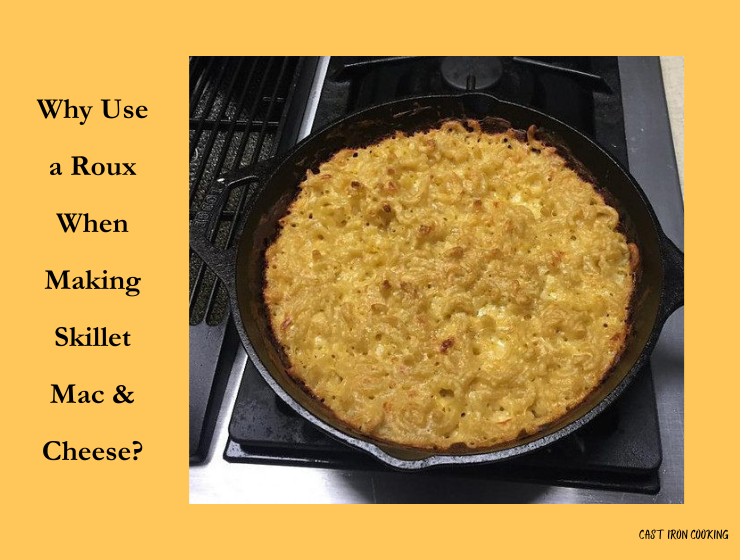So, you’ve decided to make your own macaroni and cheese instead of using a box mix.
Good call!
However, you’ve heard you’ll have to make a roux and wonder if it’s necessary.
Why use a roux when making skillet mac and cheese?
Let’s find out.
Table of Contents
Why Use a Roux When Making Skillet Mac and Cheese?
There are two main reasons to use a roux when making Mac and Cheese. First, a roux will thicken the sauce and therefore coat the pasta. And second, it emulsifies the cheese and helps the sauce stick to the pasta. Both of these things are important when making Mac and Cheese. However, there are other ways to thicken and emulsify besides using a roux, though a roux is the most common way.
1. The Roux Thickens the Sauce
Equal parts of flour and fat (usually butter), cooked together, are called a roux (roo).
A roux is used as a base for thickening sauces.
In the case of macaroni and cheese, you are making a bechamel (white) sauce when you add the milk.
And you are making a cheese (mornay) sauce when you add the cheese to the bechamel sauce.
The cheese sauce is then added to the cooked pasta. And you have Macaroni and Cheese.
You can serve it as is or throw it in the oven to bake.
Cook the pasta al dente (firm to the bite) if you plan to bake the mac and cheese because the pasta will continue cooking in the oven.
Besides thickening, cooking the roux before adding the milk removes the raw taste of the flour.
For some recipes, you’ll want a darker roux, but for macaroni and cheese, a golden or light brown is best.
A golden hue is the point at which the roux has its best thickening capabilities.
Once it reaches medium-dark brown, it begins losing its ability to thicken.
Here are the steps involved in making a cheese sauce in a cast iron skillet:
- Melt the butter in the skillet.
- Add an equal amount of flour, whisk until golden or light brown (the roux).
- Pour in the milk (anything but skim) and stir until bubbly and thickened (the bechamel sauce).
- Add the cheese and whisk until melted and smooth (the cheese sauce).
2. The Roux Emulsifies the Cheese
A roux is an emulsion or additive that helps two liquids that don’t usually mix well together, to form a single mixture.
In other words, the butter and flour cooked together (the roux) is an emulsifying agent to bind the milk and cheese together to form a smooth sauce.
It also helps the sauce to stick to the pasta.
If you just try to heat the milk and cheese together without an emulsifying agent, it will clump and remain somewhat separated. It will also be runnier, and a bit greasy rather than make a smooth sauce.
Overall, it will change the consistency of the sauce and the mac and cheese. It will affect the mouthfeel.
I tried to make macaroni and cheese without the roux or any emulsifying agent.
Everything I just wrote was true.
But the most noticeable thing was the cheese wasn’t stuck to the pasta after it was done baking. It had indeed stayed separate (as you can see in the picture below).
The mouthfeel was different, but I thought it still tasted okay.
Skillet Mac and Cheese
3. A Roux is Not Necessary
How can I say a roux is not necessary? Because a roux isn’t the only emulsifying agent.
If you want to stay away from the added starchiness of flour, some people use eggs and cheese to emulsify.
Or one recipe I found only used cheese.
It was the recipe I made (and referred to above) with some modifications.
Because it called for way more cheese than I wanted to use, I cut back to a lesser amount.
I acted as if I could get the same result without a roux.

At this point, I had little understanding of the benefits of a roux (or another emulsifying agent). Or its ability to thicken and emulsify.
And the result showed (as you can see in the picture).
If I had understood, I would have realized I needed the extra cheese to act as an emulsifier.
For this reason, I am a believer in using a roux. I see the benefits and don’t know why I would try another way.
Furthermore, I came up with a recipe that was similar to the taste of how my mom made it. And it includes a roux.
A Few Tips
Along the way, I found a few things that were helpful:
- You don’t have to use whole milk; just don’t use skim.
- Buy blocks of cheese and shred your own. Pre-packaged shredded cheese will cause your mac and cheese to be grainy.
- Don’t stick to just one kind of cheese. Experiment.
- Cheddar is by far a favorite cheese to use. So always include some cheddar.
- Make your pasta al dente if baking it in the oven.
- You don’t have to use macaroni. Other kinds of pasta also work well.
- Have all your ingredients measured out and ready beforehand.
- While your pasta is cooking, make the cheese sauce.
- You don’t have to make mac and cheese in a cast iron skillet, but in my opinion, it tastes better.
RELATED > > > > > Benefits of Using a Cast Iron Pan – 10 Things I Like
My Skillet Mac and Cheese Recipe
Ingredients
- 8 oz (2 cups) elbow macaroni
- 1 1/2 Tbsp butter
- 1 1/2 Tbsp flour
- 1 cup milk
- Salt and Pepper to taste
- 1/2 cup sharp cheddar cheese, shredded
- 1/2 cup white cheddar, shredded
- 2 slices American cheese, torn into pieces
Directions
- Preheat oven to 350°F
- Make your pasta as directed, al dente
- In a cast iron skillet, melt the butter
- Add the flour, whisk until combined, and it turns golden brown
- Pour in the milk, whisk until bubbly and thickened
- Add the cheeses, whisk until melted and smooth
- Remove from heat and add the pasta, stir until well mixed
- Put the skillet in the oven, bake for 25-30 minutes, depending on how brown you would like the top and edges
Final Thoughts
I hope you enjoyed reading about the benefits of a roux.
If you were asking, “Why use a roux when making skillet mac and cheese?” hopefully, you now have a better understanding.
And you can decide if you want to use one.
A roux is used to thicken and emulsify, which is helpful when making sauces.
And that’s what mac and cheese is: pasta and a cheese sauce mixed together.
Although there are other ways to thicken and emulsify your sauce, a roux is the most common.
Do you or will you use a roux in the future, or will you try another way?
Please let me know what you think in the comment section below.

